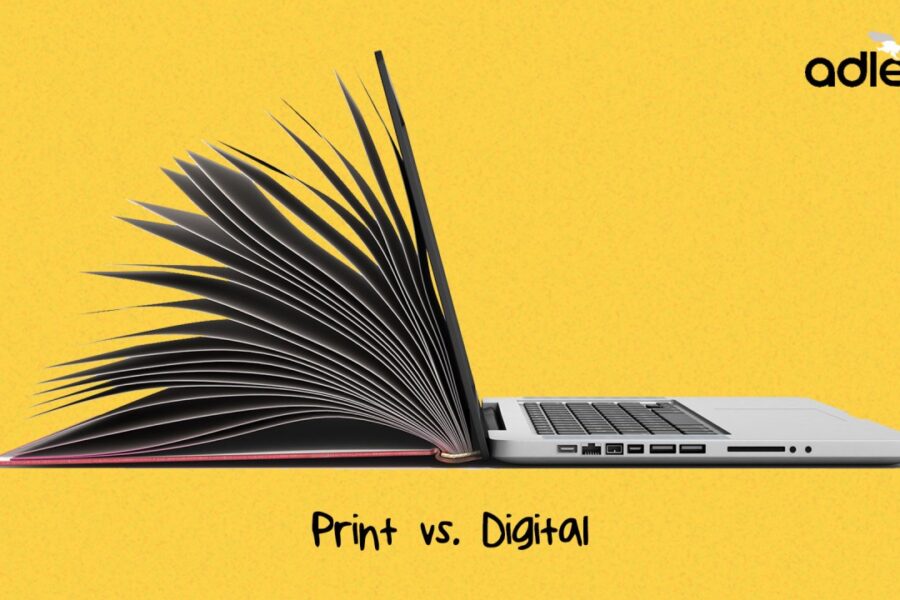Paper vs. Digital in Advertising: Embracing the Future of Marketing
In today’s fast-paced world, the advertising industry is undergoing a significant transformation. Traditional paper-based advertising methods are being challenged by the rapid rise of digital advertising. The debate between paper vs. digital in advertising is one that many marketers face as they strive to engage consumers in the most effective and efficient ways possible. While paper advertising has been a cornerstone of marketing for centuries, the digital revolution has opened up new avenues for creativity, targeting, and data-driven strategies.
In this article, we will explore the differences between paper and digital advertising, weigh their pros and cons, and discuss how AI in advertising is influencing the future of marketing strategies in both realms.
The Rise of Paper Advertising: Traditional Methods that Endure
Before the advent of the internet, paper advertising was the go-to medium for reaching audiences. Whether it was newspapers, magazines, brochures, or direct mail, paper-based ads played a significant role in shaping marketing strategies. Some of the key benefits of paper advertising include its tangible nature, ability to convey a sense of trust and credibility, and its capacity to stand out in a world increasingly dominated by screens.
Benefits of Paper Advertising
- Tangible Impact: One of the most significant advantages of paper advertising is its physical presence. Consumers can touch, hold, and engage with the material, which can create a more lasting impression compared to a fleeting digital ad. The tangible aspect of paper ads often leads to higher recall rates and increased brand recognition.
- Credibility and Trust: Many people still associate paper advertising with credibility and trustworthiness. Printed materials such as newspapers and magazines are often viewed as more authoritative sources of information. This perception can enhance the effectiveness of ads, particularly for industries that rely heavily on trust, such as finance, healthcare, and law.
- Less Distraction: In a digital environment, consumers are constantly bombarded with notifications, emails, and other distractions. Paper advertising, on the other hand, provides a distraction-free experience that allows readers to focus on the message being conveyed. This can be especially useful for businesses looking to communicate a clear and concise message without interference.
- Targeting Specific Audiences: While digital advertising allows for detailed audience targeting based on online behavior, paper advertising also allows businesses to reach specific demographics effectively. Local newspapers, for example, enable businesses to target geographic regions with precision.
Drawbacks of Paper Advertising
- Limited Reach: One of the major drawbacks of paper advertising is its limited reach compared to digital platforms. Printed materials have a fixed distribution, which means that once they are sent out or published, businesses cannot adjust their reach or target audience in real-time.
- Higher Costs: The costs associated with paper advertising can be significantly higher than digital methods. Printing, distribution, and production costs can add up quickly, especially for larger campaigns. Additionally, if a print ad underperforms, the costs are sunk, and there is no way to optimize the campaign after it has been printed.
- Environmental Impact: With growing concerns about sustainability, the environmental impact of paper advertising is becoming more important. Many consumers are now more conscious of the materials used in marketing campaigns and prefer businesses that use eco-friendly alternatives.
The Digital Advertising Revolution: A New Era of Marketing
Digital advertising has revolutionized the way businesses connect with their target audiences. From social media ads to programmatic campaigns, digital advertising allows for a level of customization, targeting, and tracking that paper advertising simply cannot match. With the rise of the internet, mobile devices, and AI-powered tools, digital advertising has become an essential component of modern marketing strategies.
Benefits of Digital Advertising
- Wider Reach: One of the biggest advantages of digital advertising is its ability to reach a global audience. With digital platforms like social media, search engines, and websites, businesses can advertise to people across the world at a fraction of the cost of traditional paper-based methods.
- Targeted Campaigns: Digital advertising offers unparalleled targeting capabilities. Through tools like Google Ads and Facebook Ads, businesses can target consumers based on specific factors such as location, age, gender, interests, browsing behavior, and more. AI in advertising further enhances targeting precision by analyzing large amounts of data to predict consumer preferences and behaviors, allowing businesses to create highly personalized campaigns.
- Real-Time Analytics: Digital advertising provides immediate feedback on campaign performance. Marketers can track impressions, clicks, conversions, and other important metrics in real-time, allowing them to optimize campaigns as they go. This level of control and flexibility is something that paper advertising simply cannot offer.
- Cost-Effective: Compared to paper advertising, digital ads are often much more affordable. With options like pay-per-click (PPC) or cost-per-impression (CPM), businesses can set budgets, test different strategies, and only pay for ads that are actually effective. This makes digital advertising an attractive option for small businesses with limited budgets.
- Interactive Engagement: Digital ads allow for interactive features like clickable links, videos, and animations. These interactive elements can capture the audience’s attention in a way that paper advertising cannot. Additionally, businesses can use digital ads to drive immediate actions, such as website visits or purchases, directly from the ad.
Drawbacks of Digital Advertising
- Ad Fatigue: With the vast number of ads consumers are exposed to online, digital advertising often faces the challenge of ad fatigue. Users may become desensitized to ads, making it harder for brands to stand out. Over time, consumers may ignore or block ads, reducing their effectiveness.
- Privacy Concerns: Digital advertising relies heavily on consumer data, which has raised concerns about privacy. The use of cookies, tracking, and AI-powered targeting has led to growing consumer awareness and regulation around data privacy, such as GDPR in Europe. While AI in advertising can help optimize campaigns, it also requires businesses to navigate complex privacy regulations carefully.
- Dependence on Technology: Digital advertising is reliant on technology, which can be a double-edged sword. While technology allows for advanced targeting and tracking, it can also lead to issues like ad fraud, technical glitches, or changes in platform algorithms that affect campaign performance.
The Role of AI in Advertising: Bridging Paper and Digital
The emergence of AI in advertising has brought new opportunities for both paper and digital advertising. AI is transforming the advertising landscape by enabling marketers to analyze consumer data at a much deeper level, create personalized experiences, and optimize campaigns in real-time.
AI in Paper Advertising
Although AI in advertising is primarily associated with digital platforms, its impact can also extend to paper advertising. AI tools can analyze consumer behavior and help marketers identify which print ads are likely to perform best with certain demographics. By leveraging data from online campaigns, businesses can make more informed decisions about where to place paper ads and how to design them for maximum effectiveness.
AI in Digital Advertising
The most significant impact of AI in advertising is in the digital realm. AI-powered algorithms can analyze massive amounts of data in real-time, helping marketers make data-driven decisions that increase the relevance and effectiveness of their campaigns. From programmatic ad buying to content personalization, AI in advertising is streamlining the entire advertising process and ensuring that campaigns are optimized for performance.
AI also helps improve targeting precision. By analyzing online behavior, AI can predict which consumers are most likely to convert and deliver the right message at the right time. This level of personalization is simply not possible with paper advertising.
Paper vs. digital in advertising: Which is Best for Your Business?
Ultimately, the choice between paper vs. digital in advertising depends on several factors, including your target audience, marketing goals, and budget. Paper advertising still holds value in certain industries and situations, particularly when targeting local audiences or creating tangible, memorable experiences. However, digital advertising offers far greater reach, precision, and real-time analytics, making it a powerful tool for businesses seeking to engage with a broader audience.
Incorporating AI in advertising into your strategy can help you maximize the potential of both paper and digital ads. By leveraging data and automation, you can ensure that your advertising efforts are both efficient and effective, regardless of the medium.
Conclusion
The debate between paper vs. digital in advertising is not one of absolutes; both mediums have their strengths and weaknesses. While paper advertising continues to provide value in certain contexts, digital advertising is rapidly becoming the dominant force in the marketing landscape. As AI technology continues to advance, businesses will be able to harness the power of both mediums to create more targeted, efficient, and impactful advertising campaigns.
By embracing AI in advertising, businesses can ensure that they are prepared for the future of marketing, delivering personalized experiences and maximizing ROI in an increasingly competitive and data-driven environment.
Paper vs. digital in advertising: Embracing the Future of Marketing
In today’s fast-paced world, the advertising industry is undergoing a significant transformation. Traditional paper-based advertising methods are being challenged by the rapid rise of digital advertising. The debate between paper vs. digital in advertising is one that many marketers face as they strive to engage consumers in the most effective and efficient ways possible. While paper advertising has been a cornerstone of marketing for centuries, the digital revolution has opened up new avenues for creativity, targeting, and data-driven strategies.
In this article, we will explore the differences between paper and digital advertising, weigh their pros and cons, and discuss how AI in advertising is influencing the future of marketing strategies in both realms.
The Rise of Paper Advertising: Traditional Methods that Endure
Before the advent of the internet, paper advertising was the go-to medium for reaching audiences. Whether it was newspapers, magazines, brochures, or direct mail, paper-based ads played a significant role in shaping marketing strategies. Some of the key benefits of paper advertising include its tangible nature, ability to convey a sense of trust and credibility, and its capacity to stand out in a world increasingly dominated by screens.
Benefits of Paper Advertising
- Tangible Impact: One of the most significant advantages of paper advertising is its physical presence. Consumers can touch, hold, and engage with the material, which can create a more lasting impression compared to a fleeting digital ad. The tangible aspect of paper ads often leads to higher recall rates and increased brand recognition.
- Credibility and Trust: Many people still associate paper advertising with credibility and trustworthiness. Printed materials such as newspapers and magazines are often viewed as more authoritative sources of information. This perception can enhance the effectiveness of ads, particularly for industries that rely heavily on trust, such as finance, healthcare, and law.
- Less Distraction: In a digital environment, consumers are constantly bombarded with notifications, emails, and other distractions. Paper advertising, on the other hand, provides a distraction-free experience that allows readers to focus on the message being conveyed. This can be especially useful for businesses looking to communicate a clear and concise message without interference.
- Targeting Specific Audiences: While digital advertising allows for detailed audience targeting based on online behavior, paper advertising also allows businesses to reach specific demographics effectively. Local newspapers, for example, enable businesses to target geographic regions with precision.
Drawbacks of Paper Advertising
- Limited Reach: One of the major drawbacks of paper advertising is its limited reach compared to digital platforms. Printed materials have a fixed distribution, which means that once they are sent out or published, businesses cannot adjust their reach or target audience in real-time.
- Higher Costs: The costs associated with paper advertising can be significantly higher than digital methods. Printing, distribution, and production costs can add up quickly, especially for larger campaigns. Additionally, if a print ad underperforms, the costs are sunk, and there is no way to optimize the campaign after it has been printed.
- Environmental Impact: With growing concerns about sustainability, the environmental impact of paper advertising is becoming more important. Many consumers are now more conscious of the materials used in marketing campaigns and prefer businesses that use eco-friendly alternatives.
The Digital Advertising Revolution: A New Era of Marketing
Digital advertising has revolutionized the way businesses connect with their target audiences. From social media ads to programmatic campaigns, digital advertising allows for a level of customization, targeting, and tracking that paper advertising simply cannot match. With the rise of the internet, mobile devices, and AI-powered tools, digital advertising has become an essential component of modern marketing strategies.
Benefits of Digital Advertising
- Wider Reach: One of the biggest advantages of digital advertising is its ability to reach a global audience. With digital platforms like social media, search engines, and websites, businesses can advertise to people across the world at a fraction of the cost of traditional paper-based methods.
- Targeted Campaigns: Digital advertising offers unparalleled targeting capabilities. Through tools like Google Ads and Facebook Ads, businesses can target consumers based on specific factors such as location, age, gender, interests, browsing behavior, and more. AI in advertising further enhances targeting precision by analyzing large amounts of data to predict consumer preferences and behaviors, allowing businesses to create highly personalized campaigns.
- Real-Time Analytics: Digital advertising provides immediate feedback on campaign performance. Marketers can track impressions, clicks, conversions, and other important metrics in real-time, allowing them to optimize campaigns as they go. This level of control and flexibility is something that paper advertising simply cannot offer.
- Cost-Effective: Compared to paper advertising, digital ads are often much more affordable. With options like pay-per-click (PPC) or cost-per-impression (CPM), businesses can set budgets, test different strategies, and only pay for ads that are actually effective. This makes digital advertising an attractive option for small businesses with limited budgets.
- Interactive Engagement: Digital ads allow for interactive features like clickable links, videos, and animations. These interactive elements can capture the audience’s attention in a way that paper advertising cannot. Additionally, businesses can use digital ads to drive immediate actions, such as website visits or purchases, directly from the ad.
Drawbacks of Digital Advertising
- Ad Fatigue: With the vast number of ads consumers are exposed to online, digital advertising often faces the challenge of ad fatigue. Users may become desensitized to ads, making it harder for brands to stand out. Over time, consumers may ignore or block ads, reducing their effectiveness.
- Privacy Concerns: Digital advertising relies heavily on consumer data, which has raised concerns about privacy. The use of cookies, tracking, and AI-powered targeting has led to growing consumer awareness and regulation around data privacy, such as GDPR in Europe. While AI in advertising can help optimize campaigns, it also requires businesses to navigate complex privacy regulations carefully.
- Dependence on Technology: Digital advertising is reliant on technology, which can be a double-edged sword. While technology allows for advanced targeting and tracking, it can also lead to issues like ad fraud, technical glitches, or changes in platform algorithms that affect campaign performance.
The Role of AI in Advertising: Bridging Paper and Digital
The emergence of AI in advertising has brought new opportunities for both paper and digital advertising. AI is transforming the advertising landscape by enabling marketers to analyze consumer data at a much deeper level, create personalized experiences, and optimize campaigns in real-time.
AI in Paper Advertising
Although AI in advertising is primarily associated with digital platforms, its impact can also extend to paper advertising. AI tools can analyze consumer behavior and help marketers identify which print ads are likely to perform best with certain demographics. By leveraging data from online campaigns, businesses can make more informed decisions about where to place paper ads and how to design them for maximum effectiveness.
AI in Digital Advertising
The most significant impact of AI in advertising is in the digital realm. AI-powered algorithms can analyze massive amounts of data in real-time, helping marketers make data-driven decisions that increase the relevance and effectiveness of their campaigns. From programmatic ad buying to content personalization, AI in advertising is streamlining the entire advertising process and ensuring that campaigns are optimized for performance.
AI also helps improve targeting precision. By analyzing online behavior, AI can predict which consumers are most likely to convert and deliver the right message at the right time. This level of personalization is simply not possible with paper advertising.
Paper vs. Digital in Advertising: Which is Best for Your Business?
Ultimately, the choice between paper vs. digital in advertising depends on several factors, including your target audience, marketing goals, and budget. Paper advertising still holds value in certain industries and situations, particularly when targeting local audiences or creating tangible, memorable experiences. However, digital advertising offers far greater reach, precision, and real-time analytics, making it a powerful tool for businesses seeking to engage with a broader audience.
Incorporating AI in advertising into your strategy can help you maximize the potential of both paper and digital ads. By leveraging data and automation, you can ensure that your advertising efforts are both efficient and effective, regardless of the medium.
Conclusion
The debate between paper vs. digital in advertising is not one of absolutes; both mediums have their strengths and weaknesses. While paper advertising continues to provide value in certain contexts, digital advertising is rapidly becoming the dominant force in the marketing landscape. As AI technology continues to advance, businesses will be able to harness the power of both mediums to create more targeted, efficient, and impactful advertising campaigns.
By embracing AI in advertising, businesses can ensure that they are prepared for the future of marketing, delivering personalized experiences and maximizing ROI in an increasingly competitive and data-driven environment.







